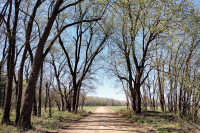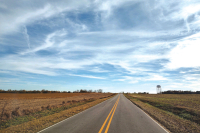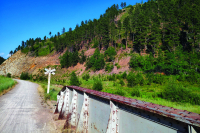The Naturalist's Corner
Bird’s the word
North Carolina’s state parks and Audubon North Carolina have joined together to celebrate the “Year of the Birds” in 2010.
Birds grab our attention. Just ask my wife, who discovered, unexpectedly, the other afternoon that the Carolina wren that nests in her clothespin basket every spring also roosts there in cold weather. I’m sure if someone took the time to translate her hastily shouted expletive it would be, “My goodness, you surprised me! I didn’t expect to find such a beautiful fluttery creature in my basket this time of year.” And nothing says spring quite like the first shiny black, white and crimson rose-breasted grosbeak that shows up at our feeder on that sunny April morning.
In fact, a 2009 U.S. Fish & Wildlife Service report estimated one of every five Americans is a “bird-watcher,” defined as someone who took a trip of at least one mile for the primary purpose of observing birds, or someone who closely observed and tried to identify birds around their home. These enthusiasts contributed $36 billion to the national economy in 2006, according to the report.
But for many around the world, across the country and here in the Old North State whose avocation is protecting and preserving our natural environment, this palpable connection between man and bird means much more than a business opportunity.
Chris Canfield, executive director of Audubon North Carolina, talked about the creation of “Year of the Birds.”
“Our partnership with N.C. State Parks began when I was asked to speak to a gathering of superintendents. I asked staff here to analyze what parklands overlapped with our Important Bird Areas program. As it turned out, about 100,000 acres of the parks, more than half of the park holdings at the time were in IBAs or potential IBAs. Lew Ledford [Lewis Ledford, director North Carolina state parks] and I put our heads together and realized we had so many common goals — expanding parks, heightening environmental awareness among the public, documenting the value of parklands for birds and other wildlife. So we committed to working together. The NC Birding Trail was one excellent outcome that grew, in part, out of that commitment. The Year of the Birds is the latest public expression of the power of both parks and birds to connect people to nature. For me, and I know for many others, noticing the birds inhabiting an area is central to my understanding of that place. Our state parks hold some of the most cherished landscapes in North Carolina, and they provide wonderful venues for the public to explore nature, including looking for the birds emblematic of each location.”
For more information regarding the Year of the Birds go to http://nc.audubon.org/news-events/north-carolina-state-parks-declares-2010-year-birds.
To find out about Year of the Birds programs in your area contact Curtis Smalling, important bird areas coordinator and mountain program manager at Audubon North Carolina, by email at This email address is being protected from spambots. You need JavaScript enabled to view it. or by phone at 828.265.0198.
Don Hendershot can be reached at This email address is being protected from spambots. You need JavaScript enabled to view it.
The Naturalist's Corner
Birrrrrding the big chill
The annual Balsam Christmas Bird Count was scheduled for last Saturday (Jan. 2). However, scary weather conditions — snow, high winds and temperatures in the low teens — especially in the northern count area, caused the count to be canceled.
My birding partner, Bobby Wood, had already made the trip over from Stecoah and I had been up for a couple of hours trying to rouse some owls before we received the news. The truck was loaded and we were in birding mode so we decided to enjoy Mother Nature’s cool offering and kick around the count circle for a while on our own.
We decided to start our morning at Lake Junaluska. The closer we got to the lake, the harder the snow was falling. The roads had a light dusting that rose and swirled at the beckoning of the north wind.
We glassed the back of the lake from the pull-off along U.S. 19. A few coots were present along with some Lake J mallards, a couple of ruddy ducks, some of the feral Canada geese and some hooded mergansers. We flushed a great blue heron from the tall grasses along the wetlands, at our second stop. We watched through our binoculars as the big blue-gray bird launched with deliberate wing beats and cut a swath through the falling snow as it lumbered across the lake.
The lake was productive, as usual, providing 14 species of gulls and waterfowl. The best finds were a lone canvasback that’s been hanging out at the lake for a while, a horned grebe and a pair of lesser scaup. Of course the colorful hooded mergansers and dapper buffleheads are always a treat to see. Plus it seemed uniquely apropos to watch ducks bobbing in the snow on a Christmas count.
We left Lake Junaluska for the Waynesville watershed. The windswept reservoir was the antithesis of Lake J, not a bird to be seen. We cruised the roads around the watershed where we found hermit thrush, white-crowned sparrow, golden-crowned kinglet, hairy woodpecker and red-breasted nuthatch among others. The winter wonderland mystique was reinforced in the watershed as we stood in a small clearing, drenched in sunlight, looking past the occasional snowflake at the dazzling white peaks above us.
We made a few other stops before wrapping up between 1:30 and 2 p.m. We wound up with a respectable winter’s morn birding total of 44 species.
While the official count was canceled this year, I want to thank the town of Waynesville and local farmer Jim Francis for once again supporting the Christmas Bird Count by allowing access to their properties. We’ll see you guys again next year.
Don Hendershot can be reached at This email address is being protected from spambots. You need JavaScript enabled to view it.
Unexpected guest
There are almost as many reasons for watching birds as there are birders. Whether you are a backyard birder content to fill the feeders and occasionally glance out the window to see who’s flitting about or a hardcore lister, traveling the globe to tick off as many lifers as possible, there’s no denying the attraction of these amazing creatures.
The seach goes on
For the past four years — five years total, if you count the magical, muddy, mystery tour in Louisiana back in 2002 — the devout, the convinced, the skeptical and the curious have slogged and paddled across the swamps of the Southeast in search of “Elvis.” That’s the code name given the ivory-billed woodpecker by searchers in Arkansas in 2004. Feeling constrained by the foot-sucking muck and the capricious currents of bayous, sloughs and slow southern rivers, searchers decided to take the high road during this year’s quixotic quest for the elusive Elvis.
Birdapalooza results
My brother and I conducted our annual Great Backyard Bird Count (GBBC) at Black Bayou Lake National Wildlife Refuge in Monroe, La., last Friday, Feb. 15. While we didn’t set any records, we had a good count. We bested last year’s total of 57 species by three and because of mechanical problems — a dead battery — we didn’t make it to the piney woods.
Wings of winter
Winter birding is often slow going. There is no chorus of rowdy and randy males singing lustily, and weather conditions can often be harsh. However, winter birding has its on set of rewards.
In living colour
Cedar waxwings and American holly are with us year round. The waxwings wander around a lot in extended family groups, but they can be spotted in any season here in the Smokies region. Holly trees don’t wander around, of course, but they are evergreen and — unlike deciduous trees — present the same general appearance all of the time. But waxwings and holly don’t really — in my opinion — come into their own until winter. The birds are so named because sexually mature males and females display a waxy-like red spot on each wing that juveniles lack. The first part of their common name indicates their fondness for the fruits that cedar trees bear.
Hits and misses
The Carolina Field Birders (CFB) conducted their sixth annual Christmas Bird Count this past Saturday (12/29.) The annual CBC count is sponsored by the National Audubon Society and is the longest running ornithological database in the world. Initiated 108 years ago, the CBC is now international in scope with more than 1,800 official 15-mile diameter circles and more than 50,000 participants worldwide.
The winter song of the great horned owl
As cool dark nights descend upon us to signal the onset of winter, the great horned owls have commenced their annual “singing” along the dark ridges above our home. These great birds don’t sing, of course, in the manner of true songbirds like warblers and orioles — but the quick cadence of four or five hoots (“hoo, hoo-oo, hoo, hoo”) given by the male, or the lower-pitched six to eight hoots (“hoo, hoo-hoo-hoo, hoo-oo, hoo-oo”) of the female serve the same purpose.
Aerial assassins
Alaskan shooters are poised to take to the skies again this year to slaughter as many wolves as possible. This is about to happen despite the fact that the Airborne Hunting Act of 1972 makes the use of aircraft to shoot or harass animals illegal and despite the fact that the citizens of Alaska have voted twice, once in 1999 and again in 2000 to ban the practice. Enough signatures have been collected this year to put the issue on the ballot again in 2008.













